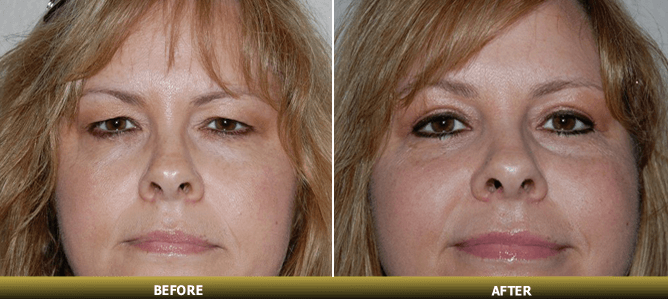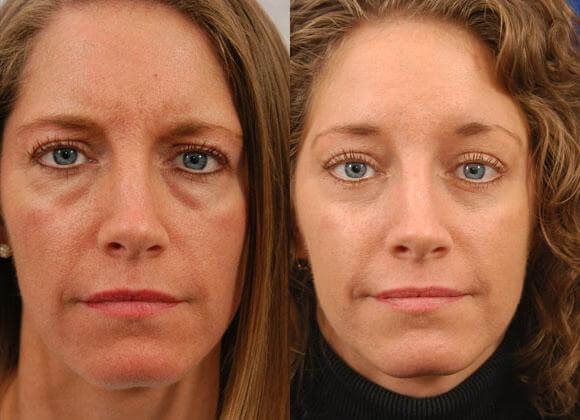 A blepharoplasty is designed to address drooping eyelids by tightening the skin around the eye. This can be used to make the eyes look tighter and more youthful or to address vision problems that are caused by the eyelid blocking the field of vision. Blepharoplasty can be used to remove skin and fat beneath the eye or to remove skin on the upper portion of the eye. This surgery is not used to address the symptoms of ptosis which requires surgeons to tighten the muscles around the eyelids.
A blepharoplasty is designed to address drooping eyelids by tightening the skin around the eye. This can be used to make the eyes look tighter and more youthful or to address vision problems that are caused by the eyelid blocking the field of vision. Blepharoplasty can be used to remove skin and fat beneath the eye or to remove skin on the upper portion of the eye. This surgery is not used to address the symptoms of ptosis which requires surgeons to tighten the muscles around the eyelids.
What Is Blepharoplasty?
Cosmetic blepharoplasty is a procedure that is used solely to improve the appearance of the eyes by removing drooping skin that has accumulated with age. As your skin ages, the skin around the eyes will stretch, weakening the muscles and displaying fat pockets that can make the eyes look tired. Oculoplastic surgeons or ophtalmologists can perform cosmetic blepharoplasty. Plastic surgeons or ear, nose and throat surgeons will also typically perform these surgeries for patients.
When Do You Need a Blepharoplasty?
A functional blepharoplasty will be performed when the loose skin on the upper or lower eyelid has dropped to the point where it impairs your vision or makes wearing contact lenses or glasses difficult. Those that have discomfort in the forehead because the muscles are straining to hold up the sagging eyelids or those that have irritation around the eyes because the folds of skin are rubbing together may require a blepharoplasty.
Who Are Good Candidates for Blepharoplasty?
Those that are unsure if they require a blepharoplasty should consult with their regular eye doctor to address these concerns and determine if this surgery would improve their conditions.
- Those that have excessive amounts of sagging skin around the eyes may consider cosmetic blepharoplasty surgery. However, it is important to remember that the skin will continue to age after the surgery is performed which may result in further sagging that necessitates a repeat blepharoplasty later.
- Before you agree to participate in a blepharoplasty surgery, your surgeon should evaluate your chances of side effects. Conditions such as thyroid eye, diabetes or dry eye problems will increase your risk of complications. Those that smoke are also at a high risk for complications because their body will heal more slowly than other patients. In many cases these conditions will eliminate your candidacy for blepharoplasty surgery.
- Because of the unique structure of their eyelids, Asian patients are more likely to experience difficulties during or after a blepharoplasty. Performing cosmetic eyelid surgery on these patients may inadvertently "Westernize" the eyes by eliminating the absent upper eyelid that is considered a common facial feature in Asian patients. Some candidates encourage this change while others will not be comfortable with this type of change.
How to Prepare for Your Blepharoplasty
You will need to determine whether or not you would prefer general or local anesthesia during your surgery. Local anesthesia patients will remain awake but the area will be numbed with medication administered with a needle. You will also be provided with an oral or intravenous sedative.
Those undergoing a complicated blepharoplasty or will have other procedures performed simultaneously will require general anesthesia that is be provided via intravenous injection. This will put you to sleep for the 20-minute to 2-hour procedure.
Patients may be asked to eat a light meal before their surgery or take certain medications like blood pressure medication before the procedure. You may also need to stop the use of pain medications or mediations that would impact your ability to clot properly during the procedure. You should not wear any makeup on the day your surgery is to take place. You should also plan to have someone drive you home and monitor your condition hours after your procedure.
What to Expect During the Surgery
- During your procedure an incision will be made along the natural fold of the eyelid to ensure that there will be no visible scarring after the procedure.
- Your surgeon will then mark what portions of the skin or muscle need to be removed and this tissue will be cut away with surgical scissors, scalpels or radio-frequency cutting devices. The amount of tissue to be removed will vary based on the underlying facial structure and symmetry of the eyebrows.
- If the eyebrow is also drooping, the skin in this area may be elevated by making an incision along the scalp and pulling the skin tighter.
- Tissue adhesives or sutures will then be used to reconfigure the eyelid and eyebrow area. Carbon dioxide laser may be applied to help smooth the wrinkles around the eye.
What Are the Potential Complications of Blepharoplasty?
Shortly after your surgery, you may find that you can't close your eye completely leading to dry eyes. This condition typically resolves itself in the following weeks or months. In the meantime dry eyes can be managed with eye drops or taping the eyes closed at night. Your surgeon may recommend massaging the eyelids after the sutures have been removed to soften the skin.
Other potential complications of a blepharoplasty include eyelid infection, vision loss due to retobulbar hemorrhage, noticeable scarring, double vision, malpositioned eyelids, under-correction, numbness of the eyelids and over-correction.
What Should You Do After Blepharoplasty?
- In the first 48 hours after your surgery, you will need to apply cold packs to the area for 10 to15-minute intervals to reduce the swelling and bruising. After 48 hours, you can apply warm compresses to promote healing.
- Your doctor may prescribe pain mediation, though the pain can usually be controlled with over the counter products. Follow any instructions from your surgeon to avoid complications.
- In most cases the sutures from your surgery will dissolve 4-7 days after surgery. Those that have received non-dissolving sutures can visit their surgeon around a week after your procedure to have them removed.
- After the surgery your eyes will appear swollen and the eye may be bloodshot. Do not wear eye makeup until these conditions have subsided. You should also abstain from wearing contact lenses until your doctor says your eyes have healed enough to manage them.
